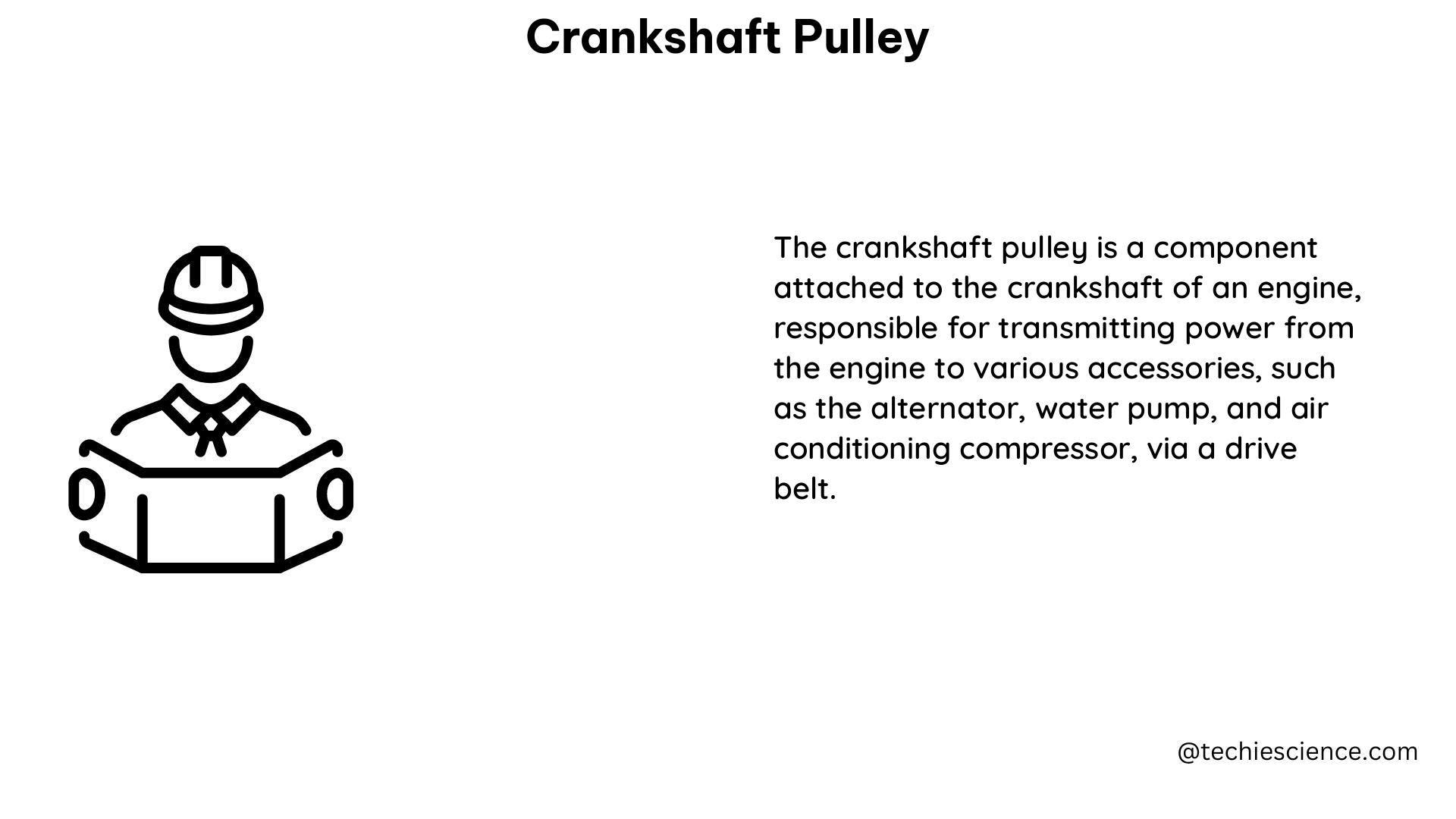The crankshaft pulley is a crucial component in an internal combustion engine’s accessory drive system. It is typically located at the front end of the crankshaft and is connected to it via a keyway. The crankshaft pulley drives various accessories such as the alternator, water pump, power steering pump, and air conditioning compressor through a system of belts. In this comprehensive guide, we will delve into the technical specifications of crankshaft pulleys, their measurement, and the effects of changing their size, as well as provide examples, numerical problems, and references for Mechanical Engineering students.
Technical Specifications of Crankshaft Pulleys
Crankshaft pulleys come in a wide range of sizes, depending on the engine’s make and model. The size of a crankshaft pulley can be measured in different ways, such as the outside diameter, the inside diameter, or the groove diameter. The groove diameter is the most common method of measurement, as it determines the compatibility of the pulley with the drive belts. To measure the groove diameter, one can use a string of dental floss and fit it into the grooves of the pulley, then measure the length of the string to obtain the diameter.
The technical specifications of a crankshaft pulley also include its weight, material, and bolt pattern. The weight of the pulley is an essential factor, as reducing its mass can improve the engine’s acceleration and overall performance. The material used to make the pulley is also critical, as it affects the pulley’s durability and resistance to wear and tear. Common materials used for crankshaft pulleys include:
- Aluminum: Lightweight and corrosion-resistant, making it a popular choice for modern engines.
- Steel: Heavier but more durable than aluminum, often used in high-performance or heavy-duty applications.
- Composite materials: Combining the benefits of different materials, such as carbon fiber or fiberglass, to achieve a balance of weight, strength, and cost.
The bolt pattern, on the other hand, determines the compatibility of the pulley with the crankshaft and the accessory drive belts. Crankshaft pulleys can have anywhere from 4 to 8 bolts, depending on the engine’s make and model.
Effects of Changing Crankshaft Pulley Size

Changing the size of the crankshaft pulley can have significant effects on the engine’s performance. A smaller pulley can increase the engine’s horsepower by reducing the drag from the accessory drive belts. This is because a smaller pulley rotates faster than a larger one, which in turn spins the accessory drive belts at a higher speed, thereby reducing the parasitic load on the engine. However, a smaller pulley can also increase the engine’s RPM at idle, which may require adjustments to the throttle position sensor and the idle air control valve to maintain a stable idle.
On the other hand, a larger crankshaft pulley can increase the engine’s torque by providing a larger moment of inertia. This is because a larger pulley has a larger mass and a larger radius of rotation, which increases the engine’s rotational kinetic energy. However, a larger pulley can also decrease the engine’s horsepower by increasing the drag from the accessory drive belts. Therefore, choosing the right size of the crankshaft pulley depends on the engine’s specific requirements and intended use.
Mechanical Engineering Examples and Numerical Problems
Example 1: A crankshaft pulley has a groove diameter of 10 inches and a weight of 5 pounds. Calculate the pulley’s moment of inertia.
Solution: The moment of inertia of a solid cylinder is given by the formula I = (1/2)mr^2, where m is the mass and r is the radius. Assuming the pulley is a solid cylinder, we can calculate its radius as r = D/2, where D is the diameter. Therefore, the radius of the pulley is r = 10 inches / 2 = 5 inches = 0.4167 feet. The mass of the pulley is m = 5 pounds. Therefore, the moment of inertia of the pulley is I = (1/2)(5 pounds)(0.4167 feet)^2 = 0.348 cubic feet-pounds.
Example 2: A smaller crankshaft pulley can increase the engine’s horsepower by 5%. Calculate the new horsepower if the original horsepower is 200.
Solution: The increase in horsepower is 5% of the original horsepower, which is 0.05 x 200 = 10 horsepower. Therefore, the new horsepower is 200 + 10 = 210 horsepower.
Figures, Data Points, and Values
- The groove diameter of a crankshaft pulley can range from 6 inches to 12 inches, depending on the engine’s make and model.
- The weight of a crankshaft pulley can range from 2 pounds to 10 pounds, depending on the material and size.
- The bolt pattern of a crankshaft pulley can range from 4 bolts to 8 bolts, depending on the engine’s make and model.
- A smaller crankshaft pulley can increase the engine’s horsepower by up to 10%, depending on the engine’s specifications and operating conditions.
- A larger crankshaft pulley can increase the engine’s torque by up to 10%, depending on the engine’s specifications and operating conditions.
References
- How do you measure a crank pulley size? – Hyundai Tiburon Forums. https://www.newtiburon.com/threads/how-do-you-measure-a-crank-pulley-size.120907/
- Explain how a smaller crank pulley makes more HP? – Corral.net. https://www.corral.net/threads/explain-how-a-smaller-crank-pulley-makes-more-hp.725453/
- Seeking: Idle RPM Data and Crankshaft Pulley Effective Diameter. https://www.fordtransitusaforum.com/threads/seeking-idle-rpm-data-and-crankshaft-pulley-effective-diameter.90608/

The lambdageeks.com Core SME Team is a group of experienced subject matter experts from diverse scientific and technical fields including Physics, Chemistry, Technology,Electronics & Electrical Engineering, Automotive, Mechanical Engineering. Our team collaborates to create high-quality, well-researched articles on a wide range of science and technology topics for the lambdageeks.com website.
All Our Senior SME are having more than 7 Years of experience in the respective fields . They are either Working Industry Professionals or assocaited With different Universities. Refer Our Authors Page to get to know About our Core SMEs.